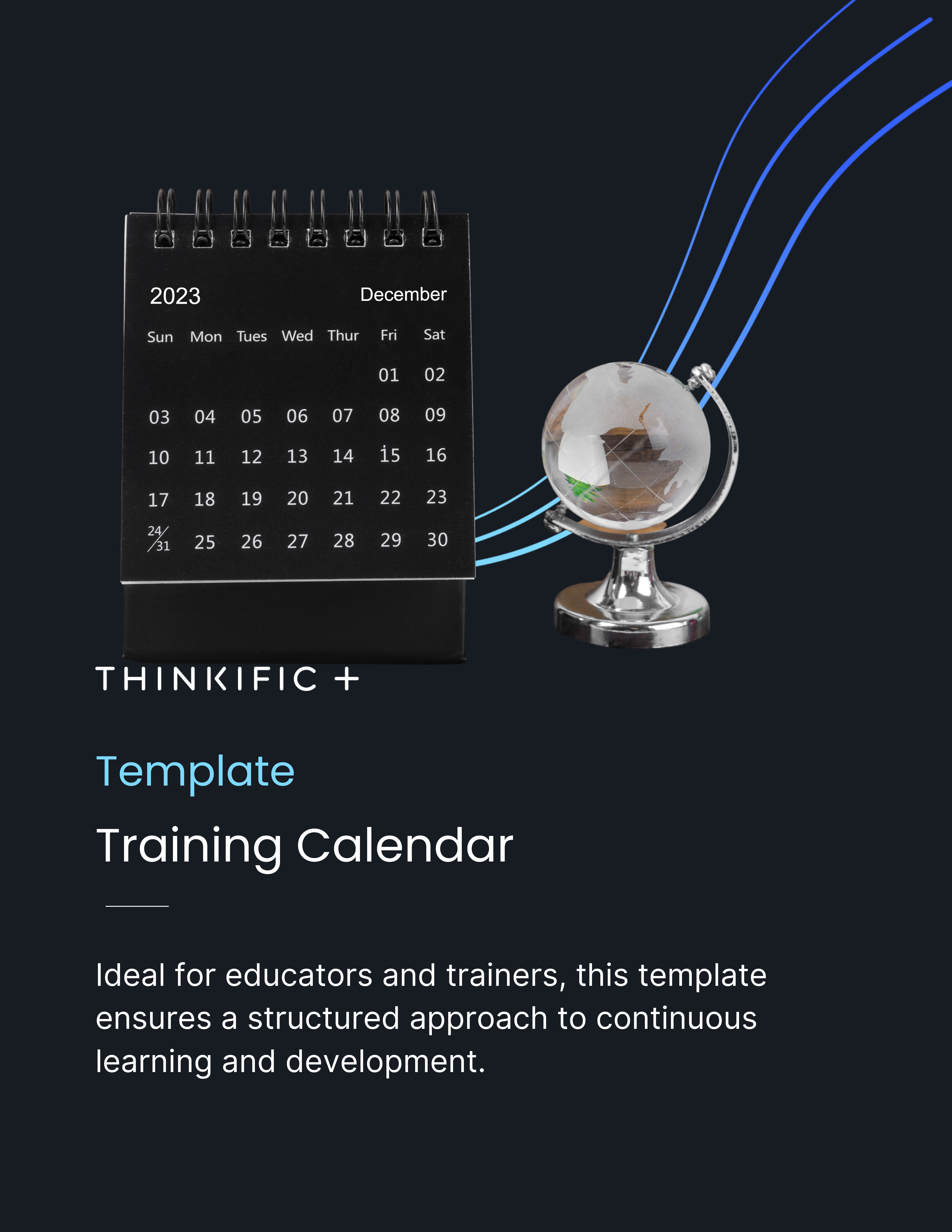
Training programs can be overwhelming, disorganized, and ineffective without proper organization. A training calendar will help you structure your sessions, keep students or employees accountable, and achieve better learning outcomes.
Creating one from scratch can be time-consuming. Luckily, there are plenty of pre-made templates that can be customized for your needs. Here’s a step-by-step guide to crafting the ultimate training calendar template.

Effective training and development are crucial for the growth of any organization and the personal development of its employees. Successful implementation depends largely on proper scheduling and organization. Training calendars are valuable tools to meet these needs.
A training calendar is a systematic, visual way of mapping out all the training sessions over a period of time. This could cover weekly, monthly, or yearly schedules, depending on the depth and duration of the training needed.
When selecting a training calendar format, it’s important to consider a few key factors that will influence the effectiveness of the training program.
Size of the TeamThe number of participants can affect the complexity of the scheduling. Larger teams might need more detailed calendars with multiple tracks to accommodate everyone’s needs.
Training FrequencyHow often the training sessions occur (daily, weekly, monthly) will determine the type of calendar you should use. A detailed daily or weekly template will be necessary if the training is intensive and regular.
Training ObjectivesThe structure of your calendar should support the goals of your training program. Templates can vary from simple date and topic listings to more complex ones with objectives, outcomes, and detailed session plans.
Type of TrainingDepending on whether the training is for onboarding, skill enhancement, professional development, or compliance, you might need different templates that focus on various aspects of planning.
Customization NeedsSome templates are more flexible and allow for greater personalization. If your training requires specific customization, look for templates that can easily adapt to fit these needs.
Integration with Other ToolsIf you use project management tools or other software for scheduling, you might need a template that’s easy to integrate or import into other platforms.
Comparison of Different Training Calendar TemplatesBased on these factors, here’s a chart that compares different types of training calendar templates typically available for use:
| Template Type | Ideal Team Size | Frequency | Customization | Integration | Best Used For |
| Simple List | Small to Medium | Weekly, Monthly | Low | Easy | Straightforward training with minimal complexity |
| Detailed Scheduler | Large | Daily, Weekly | High | Moderate | Detailed training with multiple sessions and tracks |
| Monthly Planner | Medium to Large | Monthly | Medium | Moderate | Long-term training programs with monthly milestones |
| Annual Overview | All Sizes | Yearly | Low to Medium | Difficult | High-level view of training throughout the year |
| Project-Based Layout | Medium to Large | Customizable | High | Moderate | Project-related training with interconnected tasks and roles |
This chart is a simple guide to help you choose the layout that best suits your organizational needs. After selecting the appropriate template, you can customize it further to match your specific training schedule, add branding, and include unique organizational requirements.

Creating a comprehensive training calendar doesn’t have to be a daunting task. Here’s how to use a training calendar template el efficiently:
Step 1: Choose an Appropriate TemplateUsing the chart above or a list of available templates, pick one that suits your team’s size, training frequency, and objectives.
Step 2: Customize the Template to Your NeedsEven the most detailed template will need to be tweaked for your specific goals.
Make sure you are thinking about the employees, students, and trainers using this template. If special accommodations are necessary, implement them here.
Step 3: Automate Where PossibleThe whole point of a template is to save time and resources. Automation can scale those savings considerably if you transfer your template to a tool like Excel. Here are some tips to get started:
Should you need to, ensure your calendar can be synced or imported into project management tools or other software your team uses.
Comprehensive learning management systems (LMS) often have built-in integrations for popular calendar programs.
Step 5: Share the CalendarOnce your calendar is set up and ready, share it with your team or training participants. Excel allows you to export the calendar as a PDF or share it through cloud-based services such as OneDrive or Google Drive for real-time collaboration.
Step 6: Maintain and Update RegularlyAs the training program progresses, keep the calendar updated. Adjust dates as necessary, mark completed sessions, and update the document with any new information that becomes relevant.
Tips for Streamlining the Scheduling ProcessRemember, the calendar should be efficient and streamlined to benefit all stakeholders. Here are some tips:
By following these steps, your training calendar will be an efficient tool for organizing and managing your organization’s training program.

The choice between free or premium training calendar templates depends largely on your organization’s specific training needs, the complexity of its training programs, available budget, and the level of customization and support desired.
Free Training Calendar TemplatesFree templates are an excellent starting point, as they offer fundamental features without any investment—other than the time it takes to adapt them to your needs.
This can be a significant advantage for small businesses, startups, or individual departments with limited resources. While the cost-effectiveness of free templates is clear, they often feature a one-size-fits-all design. This means you might need to invest more time in modifying them to suit your specific training plans.
Despite their flexibility, free templates have significant limitations, including a lack of advanced features. For instance, they may not support automatic updates or integration with other systems, leading to more manual work to maintain the schedule.
Premium Training Calendar TemplatesPremium templates, on the other hand, are paid resources catering to more detailed and complex requirements. They usually have many advanced features, such as:
Such templates can save considerable time in the long run, help avoid scheduling conflicts, and provide useful insights to enhance training effectiveness.
But of course, this comes at a cost—both monetary and potential complexity. A more feature-rich template might require training to use efficiently, which can be a hurdle for some teams. Additionally, the ongoing costs of premium services may not be justifiable for every business, particularly if the training needs are straightforward.
Considering the diverse range of templates available, we’ve compiled a list of top free training calendar templates to get you started. Experiment with these, and don’t hesitate to explore premium options if they align better with your organization’s needs.
Advanced Features in Excel for Training CalendarsIf you choose to create and transfer a training calendar to Excel, leveraging advanced features can significantly enhance its utility and user experience. Let’s dig into how you might use these in the context of a training calendar.
Conditional formatting in Excel can make certain data stand out through color coding, which makes it ideal for visualizing the status of training sessions or highlighting key dates. Here are the steps to apply conditional formatting:
Highlight Upcoming SessionsSelect the range of dates in your calendar. Then navigate to ‘Home > Conditional Formatting > Highlight Cells Rules > A Date Occurring.’ You can then highlight only the cells containing dates within a certain time range, such as “Next Week” to flag upcoming sessions.
Visualize Completion StatusFirst, add a column where you’ll mark sessions as “Complete,” “In Progress,” or “Not Started.” Then select the range of cells in this column and go to ‘Home > Conditional Formatting > Highlight Cells Rules > Text that Contains’. Set different colors for each status for a quick visual reference.
Format Based on ValuesIf you’re tracking attendance or scores, you could use conditional formatting to color-code cells or rows based on the values to instantly see where there might be issues. For example, ‘Home > Conditional Formatting > Color Scales’ can show a gradient of colors reflecting high to low attendance.
Pivot tables are excellent for summarizing and analyzing large amounts of data, which can be useful if you manage extensive training programs with multiple sessions and participants.
They allow you to quickly pivot different data points, such as attendance rates, average scores, or feedback ratings, to identify trends or areas that need attention. To create a pivot table:
These features help keep your training program organized, enable faster data analysis, and ensure that data input is more accurate and reliable.
Best Practices for Maintaining Your Training CalendarMaintaining an accurate and up-to-date training calendar is essential for the smooth running of any professional development program. Regular maintenance ensures everyone involved can access the latest information, facilitating optimal attendance and engagement.
Here are some best practices to follow as you maintain your monthly training calendar template:
Regular UpdatesReview your training calendar on a set schedule. The frequency of this schedule can vary—some may need to check daily, while others might find a weekly or monthly audit works just fine.
It is also a good practice to adjust the calendar as soon as changes, session completion, or feedback arise. Incorporating changes immediately maintains clarity and reduces the workload of bulk updates.
Feedback IncorporationFeedback is a valuable tool for continuous improvement. After each session, collect feedback from participants and trainers and use this information to refine the program and calendar.
This feedback can offer insights into the effectiveness of:
It shows participants that their opinions are valued and that their contributions can shape the training program. In your training calendar, you may designate a section for notes or comments to record such feedback for easy reference when planning future sessions.
Effective Communication StrategiesCommunication is central to a useful training calendar. Ensure all stakeholders, including trainers, participants, and management, are informed of updates and changes.
When updates occur, communicate these changes promptly and clearly to avoid misinformation.
Finally, consider accessibility when maintaining your training calendar. Store it in a shared location accessible to all relevant parties. Tools like cloud storage services can be particularly helpful, allowing team members to view and interact with the calendar wherever they are, provided they have the necessary permissions.

Thank you for exploring training calendar templates with us.
Ready to take the next step and get personalized guidance to streamline your professional development and training?
Request a call with a member of our Thinkific Plus solutions team today, and let us help you unlock the full potential of your training with online learning.

Excel training calendar templates are user-friendly, customizable, scalable, cost-effective, and have built-in tools for data analysis.
Customize your annual training calendar templates in Excel by adjusting the layout, formatting, adding or removing columns, setting data validation rules, and incorporating your organization’s branding.
Look for templates that allow ease of use, flexibility, data visualization options, space for detailed descriptions, and the ability to track multiple training programs.
The frequency of updates should match the pace of changes in your training schedule—generally, aim for weekly updates or immediately after any changes occur.
Daniela Ochoa is the go-to Content Marketing Specialist at Thinkific Plus. With years of experience in marketing and communications, she is passionate about helping businesses grow through strategic customer education, content marketing, and online learning at scale.

Most Popular

The best ChatGPT prompts for trainers looking to incorporate AI into your training program planning and development process.

A full guide to email marketing strategy so you can start nurturing and converting your customers to take your business to the next level.

Discover how to capture essential feedback with our comprehensive training and development survey template. Tailored for trainers, this guide offers powerful insights into designing an effective questionnaire.

Most Popular